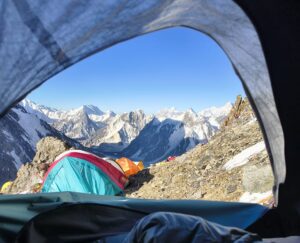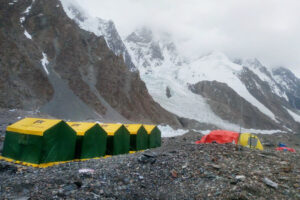John Snorri and the Sadparas are already experiencing the hardships of the Karakorum cold season. Although they reached Goro 2 camp today, snowed-in trails have slowed them down, and they now expect to reach Base Camp on Saturday or Sunday.
Even this estimate could be too optimistic, according to K2 winter veteran Jacek Teler, who will help ExWeb analyze the upcoming winter season. “As Sadpara knows well, arriving that quickly at K2 Base Camp, even in summer, is unrealistic,” Teler said. The Polish climber estimates that even December 8, next Tuesday, may be a stretch.
Further delays will come if the climbers have to move supplies previously deposited on the way to BC. “In winter, moving loads even one kilometre means another lost day,” Teler said. “Despite people’s plans, winter is the one dealing the cards here.”
Carlos Garranzo, a member of Seven Summit Trek’s winter K2 team, finally managed to escape his warm Spanish home town — under lockdown until recently — and travel to the Alps to test gear and train on snow and ice before heading to Pakistan on December 18.

Sophie Lenaerts in Skardu, earlier today.
Meanwhile, Sophie Lenaerts, Stef maginelle and Jean-Francois Spellman are also about to start climbing and skiing on the pristine peaks of Biafo-Hispar. The Belgians flew from Islamabad to Skardu today, experiencing a temperature shift from 22ºC to 5ºC within a couple of hours. Tomorrow, they drive to Askole, the starting point of their trek to the Biafo Galcier and Snow Lake. Temperatures there are already below zero.

Felix Berg gets a taste of Pakistan’s ice in the Shimshal Valley. Photo: SummitClimb
Felix Berg is also in Pakistan, on his second trip to the Shimshal this year. Berg recently spent four weeks training local guides and leading a client on some icefall climbing. He attempted to solo a peak but turned back at 5,300m. Finally, during the region’s few good days, he explored the Momhil Glacier area.
“We climbed some 6,100m peak, but I still have to figure out if it has a name or been climbed,” Berg told ExplorersWeb. Mainly, their weather has been pretty bad, with falling temperatures that presage full-on winter. “At the end, it was -15°C at night, and never above -5°C in the sun at about 3,000m.”

After summiting Ama Dablam, Sophie Lavaud and Sengay Sherpa have now targeted an unclimbed 6,000m peak in Langtang. Photo: Sophie Lavaud
Overall, the quiet season has allowed local climbers to pursue their own goals. Dawa Steven and Sonan Sherpa, for example, enjoyed a cool heli-bike ride down the Everest trail. A helicopter dropped them at the Kala Pattar (5,440m). From here, they cycled down 1,000 vertical metres each day, stopping first at Dingboche and then Namche Bazaar.

Dawa Steven (left) and Sonan Sherpa at Kala Pattar, making mountain bikers around the world envious. Photo: Dawa Steven
Likewise, in South America, locals Raimundo De Andraca, Antonio Eguiguren, Sebastían Rojas, Nicolás Valderrama and Galo Viguera drove to Patagonia and climbed Cerro San Valentín via its normal route in six days. They then carved a new ski line down its south face. San Valentin (4,040m) is Patagonia’s highest peak and rises from the edge of the Northern Patagonian Ice Field.

The new ski line (in red) on the wild Cerro San Valentín. Photo: Patagonia Vertical






